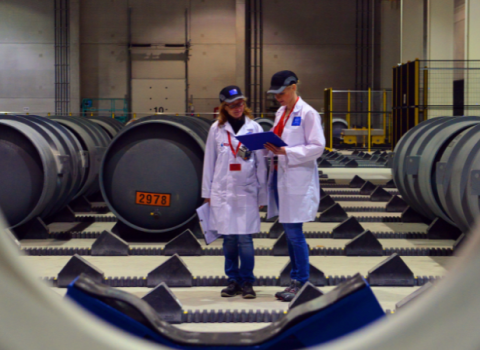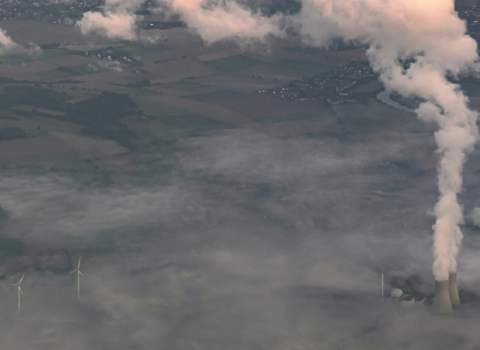But although necessary for energy independence, the European Fusion Association admits it’s unlikely to be cheaper than solar or fission

Milena Roveda (left), chair of the European Fusion Association's (EFA) executive board and chief executive of Munich-based Gauss Fusion, and Anders Wulff (right), EFA board member.
Europe needs to back nuclear fusion to help achieve energy independence, a new European industry body has argued, whilst at the same time acknowledging this source of power is unlikely to ever be cheaper than existing nuclear fission or solar.
The European Fusion Association (EFA) was founded by 12 companies in October to push their interests in Europe, which has lagged behind the US in establishing private fusion startups.
National governments like Germany have launched big investment schemes to catch up; last year Berlin pledged €1 billion of research funding. Incoming research commissioner Ekaterina Zaharieva was pressed on nuclear research funding, including for fusion, by MEPs during her confirmation hearing earlier this month.
But the rise of ultra-cheap solar power, plus cost effective batteries to store it, has arguably undercut the environmental and price logic of developing fusion. Why bother creating nuclear fusion on earth when we can already harness the reaction occurring in the sun?
Milena Roveda, chair of the EFA’s executive board, said that before she entered the fusion industry two years ago, she shared similar scepticism, asking herself, “Why are we [developing fusion], when “there is sun, there is wind, there is nuclear in terms of fission.”
But arguments about energy security, and the cost of building out the grid to accommodate renewables, changed her mind. “Now I am convinced,” said Roveda, who is also chief executive of Munich-based Gauss Fusion.
The problem with relying on solar and other renewables, and on battery storage of these intermittent power sources, argues EFA board member Anders Wulff, is that it creates a dangerous dependence on China.
“Autonomy for Europe is not there with respect to solar panels,” he said, given that China dominates their manufacturing.
The European solar industry claims that with support it can carve out at least some market share in the face of cheap Chinese competition. But Wulff says this will always be an uphill battle.
“You will never be able to catch up with China on this,” he said, as it’s near impossible for “fractured” Europe to compete with a “unified country”.
For Wulff, nuclear fusion is a way to create European independence without being reliant on China. Meanwhile, Roveda argues it would reduce Europe’s dependence on Kazakhstan, Niger or Russia, for the uranium to power fission plants.
EFA also points out that a massive expansion of renewables will require a huge modernisation of energy grids to link up new solar panels and wind turbines, and deal with fluctuating output.
Wulff references a 2023 report from the International Energy Agency, which warns global investment in the electricity grid needs to double by 2030 to $600 billion a year or risks becoming a bottleneck to the rollout of renewables. The same report does, however, say that rapidly cheapening storage batteries can alleviate some of these problems.
Cost and timelines
But when in this century fusion will provide a commercial power source remains unclear. At one end of the spectrum, US fusion firm Helion has promised to generate electricity for Microsoft from 2028. But Demo, the drawing-board successor to the ongoing ITER experimental reaction project in the south of France, envisages producing electricity by 2060 (and even then, not at commercial scale).
“The truth is, nobody knows,” said Roveda, although she is banking on “exponential development” in the fusion sector.
At least in the media, fusion energy is often spoken of as being potentially “limitless”, implying radically lower energy costs.
But Roveda is also keen to dampen down the idea that fusion would provide cheaper energy than we have at the moment.
“[There is] not a consensus that fusion power is going to be cheaper than solar,” she said. “What we say is that fusion is going to be in the mix alongside solar.”
What’s more, Roveda doesn’t even expect fusion to be cheaper than current nuclear fission.
“Talking about a mass scale, there is no reason to believe that a fusion power plant is going to be any cheaper or considerably cheaper than a fission power plant,” she cautioned. “The concrete is the same, the steel is the same.”
Fusion plants will need complex tritium blankets - yet to be invented wrap-arounds that regenerate the ultra-rare fuel that should power fusion reactions, she said.
“Basically, speaking, in broad numbers, the cost is going to be the same and the output the same [as fission],” she said.
In addition, the first fusion plants are “absolutely not going to be economic at all,” Roveda said. Some tens of plants will have to be built before economies of scale kick in and costs reach those of fission.
“We don't see that fission is going to disappear completely, but it's about balance in the mix,” she said.
Industry consolidation
There are also fears of an impending valley of death in the private fusion industry, as start-ups try to find the money to build expensive prototype plants in a world of high interest rates.
Currently, the global Fusion Industry Association (FIA) counts 45 companies trying to commercialise fusion. Unlike the global FIA, the EFA has opened full membership to fusion supply chain companies, not just those looking to actually build power plants. It’s also open to research institutes and universities.
Right now, just one or two firms are actually in the “engineering phase,” said Roveda. “I personally think is that there is going to be a serious consolidation in the industry,” she said. “So in a couple of years, we won't see 40 plus companies out there all claiming that they are going to build a power plant”.
This isn’t just a problem of money, but of people – there aren’t enough fusion specialists to serve more than 40 companies.
In 2024, the industry received $1 billion of investment, according to the FIA – not bad, but an incremental improvement on the roughly $6 billion it had already raised.
“If funding into private fusion companies only grows at $1 billion per year over the next decade, the industry will not meet its bold targets,” the FIA warned in its most recent report.
This raises the question of how serious some fusion startups are in their plans. But Roveda says it’s not the EFA’s job to vet members on the feasibility of their ideas.
“If tomorrow a company comes and pays their fee and says, we're going to put fusion on the grids in two years time, I don't see on which basis we as an association can say, you are not serious,” she said. “So we are not a technical committee.”
ITER backing
Although the EFA primarily represents private fusion businesses, Roveda only has praise for publicly-funded ITER, being built by a global consortium of countries including the EU, despite numerous delays and cost overruns.
“ITER has brought a lot of things to the fusion community, and one of the things has been the creation or the start of a supply chain for fusion,” she said.
It’s ITER that means Europe, not the US, is the world leading supplier of parts and expertise for the fusion industry, she argues.
“Private US fusion companies are coming to Europe to buy components for what they are doing,” she said. “So the supply chain is in Europe […] scientists, the big labs, you have a lot in the US, but really the bulk is in Europe.”
Intellectual property
Right now, one of the EFA’s biggest priorities is clearer intellectual property rights.
“If you are intended to get private money, you need to really solve the problem of IP, because the first question from a private investor is, who is the owner of the intellectual property?” said Roveda.
Currently, it often resides with public research institutions, making it hard to win private funding. “The investor is not going to put one dime on the table if the money is going to the research institutions,” she said.
The EFA has been lobbying the German government on exactly this point, she said.





 A unique international forum for public research organisations and companies to connect their external engagement with strategic interests around their R&D system.
A unique international forum for public research organisations and companies to connect their external engagement with strategic interests around their R&D system.